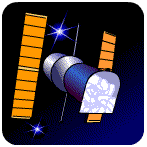The Hubble Space Telescope
Created | Updated Jan 28, 2002

The Hubble Space Telescope is a 2.4m reflecting telescope located 600km above the Earth's surface. It is for astronomers, probably the most important space probe ever launched. It has gathered an enormous amount of information about the Universe. Exploration probes have been sent to the outer reaches of the Solar System, however telescope are the only way to see further.
Space Astronomy
Space is the ultimate location for an observatory. From the ground astronomers have always been frustrated by the limitation of looking through the atmosphere, and have travelled to distant locations in their search for clear, cloud-free skies. Telescopes have been built in the Atacama Desert in Chile, on the summit of Hawaiian volcanoes and in Antarctica.
However even on a perfectly clear night on a mountaintop in the desert, the atmosphere still causes problems. As the air is continuously moving, a ray of starlight is refracted in a random direction causing the star we see to twinkle. This twinkling is extremely irritating to astronomers as it blurs the images from telescopes, leaving the resolution of the largest observatories no better than that from a 10cm telescope. (Larger instruments are built to collect more light, producing brighter images but with the same resolution). The only way to entirely avoid this problem is to launch a telescope into space. This is why NASA built the Hubble Space Telescope.
The Hubble Space Telescope
The Hubble Telescope was launched in 1990. During its eleven year lifetime, it has made innumerable contributions to astronomy, from studying the solar system and the formation of planets, to imaging distant galaxies.
All this followed a rather shaky start. After the telescope was deployed in space, the primary mirror was found to be two micrometres too shallow due to an alignment error during grinding. This reduced the resolution by a factor of seven to a level no better than a well sited ground observatory. Fortunately the telescope was designed as a 15-year project with regular servicing missions to maintain and upgrade components. During the first servicing mission in 1993 additional optics were installed to correct this effect, although it never achieved the resolution initially hoped for.
While operating an observatory in orbit avoids the problem of seeing through the atmosphere. It introduces a great many other difficulties. Launching a 4x13 metre cylinder is no easy task, and like all space probes everything has to work automatically and with minimal maintenance.
The Hubble Deep Field
The competition among astronomers to gain access to big telescopes is intense. Dozens of research proposals must be written for just a few nights observing time; researchers then spend months arguing about which stars or galaxies they should look at. When they finally get their hands on the controls, they don't waste time looking at anything else.
However in 1995 NASA took the unprecedented decision to point the Hubble telescope at a patch of clear sky for ten days. This apparently strange behaviour has produced some of the most interesting images of the universe, known as the Hubble Deep Field. By integrating the light received over this period, the telescope could resolve fainter galaxies at greater distances than have ever been resolved from the Earth. As the light from these objects has travelled billions of light-years, we see them as they were billions of years ago when the Universe was only a fraction of its present age, this has given us fascinating information about the evolution of the Universe
The Next Generation Space Telescope
The Hubble Space Telescope will survive well into this decade. However scientists are already working on the Next Generation Space Telescope or NGST, which could be launched as early as 2007. This instrument will have an eight metre diameter mirror (compared to Hubble's 2.4m reflector) making it a lot more sensitive, allowing it to resolve even more distant galaxies. And hopefully providing answers to some of the questions the Hubble telescope has raised.
However NGST is not simply a bigger model of Hubble, that would probably be impossible to launch. Instead it will be a new design using a lightweight segmented mirror, which will unfold in space. This designs creates further difficulties in trying to keep the shape of such a mirror steady, it is necessary to continuously monitor the image from the telescope and adjust the shape of the mirror to keep it sharply focussed.
By the middle of this century, astronomers could be using observatories on the far side of the moon, or vast arrays of telescopes set up in the outer reaches of the Solar System. However this does not mean that ground based astronomy is on the way out. Space telescopes are likely to remain a very expensive option, and the difficulties of working in space mean their performance may be limited by other factor, such as how steady a segmented mirror can be kept.
Meanwhile back on Earth, scientists are developing techniques such as Adaptive Optics to overcome the effects of the atmosphere. And on the surface it is much easier and cheaper to assemble huge observatories.
